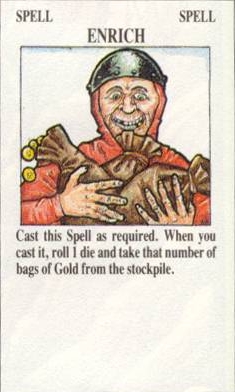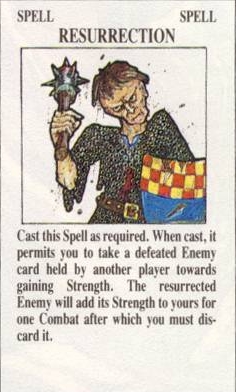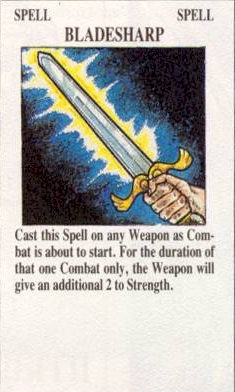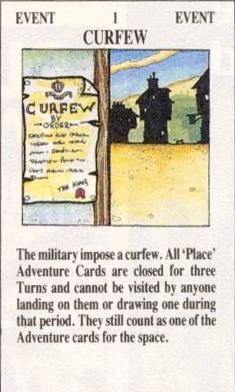
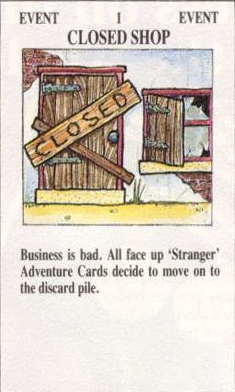
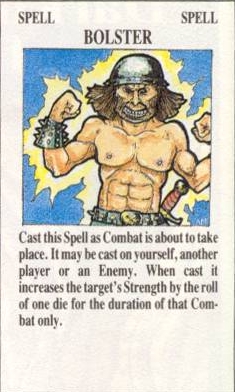
The Jewel in the Crown
A Look at Talisman and its New Expansion Set
by Alastair Morrison
I tend to buy games for one of two reasons. Either it is a good, playable system, or it has a great box! I admit it was the second reason that initially attracted me to Talisman, however, once I looked inside, I discovered that not only was the artwork excellent but the game was good and playable too.
For those of you unfamiliar with the game, the board itself consists of three distinct regions. The outermost region, coloured in green, is easiest to travel through, followed by the blue middle region and the buff inner region, wherein lies your goal - the Crown of Command. In the game, each player takes on the role of a character such as a Warrior, Wizard or Priest, each of whom has special powers, and sets off on a quest to find the magic Talisman. The regions on the board are the areas of 'countryside' travelled through, and each region is actually sub-divided into squares, each of which has its own title (eg Chapel, Hills, etc) and encounter instructions. Effectively, Talisman is a regulated role-playing boardgame.
There are fourteen character cards and pieces which depict the individual adventurers: a Prophetess, Druid, Warrior, Ghoul, Priest, Wizard, Sorceress, Monk, Troll, Elf, Thief, Assassin, Minstrel and Dwarf. Each card gives details of the character's unique abilities. For example, the Prophetess can begin the game with one spell, always retain one, and look at the other players' spells at any time during the game. Character cards also show your initial Strength, Craft, Lives, Gold, Alignment and starting location.
Over a period of time, each character seems to develop its own personality, regardless of who plays them. One example is the Troll; not the most personable of characters, but one who tends to develop Massacrevellian (rather than Machiavellian) tactics. After all, why be subtle and devious when pure brute force will get you the same results - and faster!
Spell cards are another important facet of the game - each one gives specific details as to the type of spell you can cast in the course of the game. For the greedy, the Acquisition spell is a good one, although my favourite has to be Temporal Warp- a spell that enables you to take three turns in a row.
One unpleasant aspect about the game is being turned into a Toad as a result of a spell. This invariably happens when your character has acquired enough Gold to bury Fort Knox, an armoury that would overburden the hordes of Genghis Khan and enough number of Followers to fill a football pitch. Since a Toad cannot carry anything, all his worldly wealth remains on the space he occupied when the spell struck. This usually results in a mad scramble by the other players to be the first to reach this unexpected treasure trove. All the poor Toad can do is sit and croak his objections in vain for the next three turns.
After playing Talisman on numerous occasions with anything from two to six players, it becomes obvious that it is ideally suited to the three to four player game since it keeps the playing time down to about two and a half hours yet still offers an interesting challenge.
Having said this, the six-player game is perfect for role-players, allowing plenty of character interaction and development as each player seeks the Weapons, Objects and Talismans that are now in short supply. This is a game of back-stabbing, cheating and corruption, with spells, curses and blood flying across the board. An interesting variant is to have only one Talisman. The player who eventually gets it would be sure to spend most of the game being pursued by a bunch of frothing maniacs bent on grievous bodily harm (at the very least!).
The one complaint that is often levelled at card-orientated games like Talisman is that after numerous plays you can often predict the cards, losing the elements of spontaneity and surprise. To combat this, an expansion set has arrived on the scene, containing new Character, Spell and Adventure cards.
These additions follow the same format as the original game, with the added bonus of glorious technicolour throughout. New characters are the Halfling, Necromancer, Satyr, Leprechaun, Ranger, Amazon, Rogue, Hobgoblin, Gladiator, Knight, Barbarian, Merchant, Pilgrim and Philosopher, making twenty-eight different characters available to players. Of these newcomers, the Necromancer and the Knight can benefit
from gaining Craft through Charming enemies or killing them, adding the
enemy's Craft to their total. Thus these two can gain when they encounter spirits - an ability lacking in the original characters. All the new characters have a good balance of abilities, making them as playable as the original set.
The Adventure cards all add plenty of variety and sparkle to the game. To describe in length all the novelties would use up all the superlatives I know (at last count about five) so I'll just pick out a few favourites.
The Arena card allows you to move any other character to your space and then attack them. This enables you to pick on the weakest player and act very uncharitably towards him. On the subject of uncharitability there's also a Taxation card to get... There's also an unhelpful stranger in the form of a Judge - he can fine you or make you miss a turn if you've attacked another player during the game. Going by the way most people I know play Talisman, it's certainly a case of 'Guilty, m'lud'!
Out of nine new enemies provided, the nastiest by far has to be the Lich. If the Lich is victorious in combat, it drains one of your character's lives and keeps it for itself. This makes it a very persistent enemy, especially if encountered early on in the game whilst the player characters are still weak and inexperienced. My other favourite enemy is the Berserker who instead of being killed merely zooms off clockwise to another space, ready to bash again.
The half-dozen new spells - Displacement, Brainwave, Slow Motion, Barrier, Mind Steal and Metamorph, are all good for a bit of chaos here and there.
There is, of course, nothing to stop you adding new adventure cards or favourite character cards of your own. It is easy to adapt any character type to Talisman, as long as you keep within the limits of the rules, it shouldn't unbalance the game.
To use the Talisman cards provided on the facing page, first cut around the sheet of card backs and paste this to a sheet of thin cardboard. When the glue has dried, trim the cardboard to the size of the cards, cut out the obverse sheet and paste this to the other side of the cardboard, making sure that the two sides correspond to each other! Once dry, cut the cards out individually and use them to brighten up your game!



